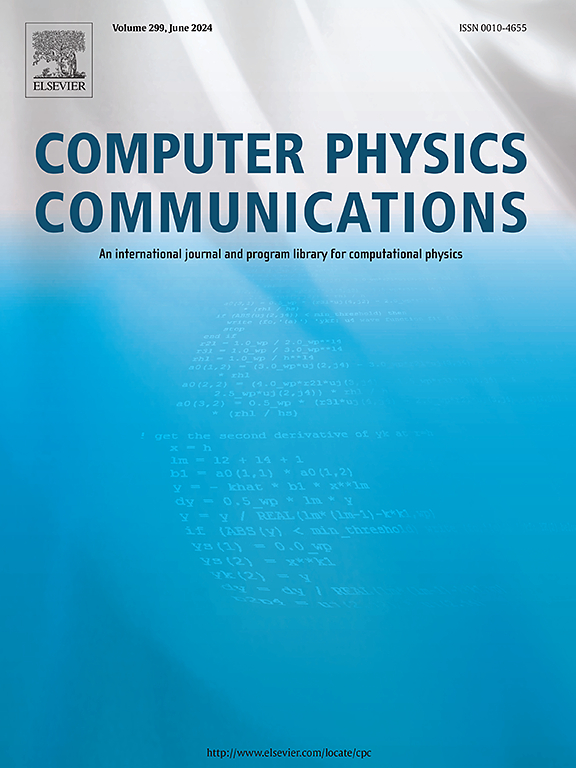TROPIC: A program for calculating reduced transition probabilities
IF 3.4
2区 物理与天体物理
Q1 COMPUTER SCIENCE, INTERDISCIPLINARY APPLICATIONS
引用次数: 0
Abstract
Measurements of level lifetimes and the extracted transition probabilities are one of the cornerstones of nuclear structure physics. The reduced transition probabilities, yield information about the structure, wavefunctions, and matrix elements of excited states connected by electromagnetic transitions in a given nucleus. The arsenal of techniques for measuring lifetimes continues to expand and presently includes a wide range of values from femtoseconds to microseconds. While lifetime measurement techniques vary, the extraction of transition probabilities remains the same. RULER is the program used by the National Nuclear Data Center (NNDC) and ENDSF evaluations, while TRANSNUCLEAR was developed at the University of Cologne and modified by a variety of groups. This paper presents a new program TROPIC (TRansitiOn ProbabIlity Calculator), which is the most modern and efficient way to extract transition probabilities . TROPIC is a program written in Python 3 with the NumPy and SciPy libraries. This is in line with the advances that ENSDF and NNDC are making in moving away from the 80-character card punch input formats. Several design features were implemented to provide a streamlined process for the user and mitigate drawbacks that were present in other programs. The results from TROPIC have been compared with TRANSNUCLEAR and RULER. The answers are as expected identical, but the investment of input to output time is significantly reduced. TROPIC will be made available for public domain use, along with a user guide and example files.
Program summary
Program Title: TROPIC
CPC Library link to program files: https://doi.org/10.17632/958ygp2sb4.1
Developer's repository link: https://github.com/ND-fIREBall/TROPIC
Licensing provisions: GPLv3
Programming language: Python 3
Nature of problem: An efficient way to calculate multiple reduced transition probabilities with minimal effort invested from the user.
Solution method: A Python 3 script has been developed to read in a CSV file containing all necessary input parameters, calculate the transition probabilities listed in the CSV file, and export the results in three different output formats.
TROPIC:计算降低过渡概率的程序
对水平寿命和提取的转变概率的测量是核结构物理学的基石之一。还原的转换概率 B(πλ;Ji→Jf)提供了有关特定原子核中通过电磁转换连接的激发态的结构、波函数和矩阵元素的信息。测量寿命的技术库不断扩大,目前包括从飞秒到微秒的各种数值。虽然寿命测量技术各不相同,但对跃迁概率的提取却保持不变。RULER 是美国国家核数据中心(NNDC)和 ENDSF 评估所使用的程序,而 TRANSNUCLEAR 则是科隆大学开发的,并由多个小组进行了修改。本文介绍了一个新程序 TROPIC(过渡概率计算器),它是提取过渡概率 B(πλ)的最现代、最有效的方法。TROPIC 是用 Python 3 和 NumPy 及 SciPy 库编写的程序。这与 ENSDF 和 NNDC 在摒弃 80 个字符的打卡机输入格式方面取得的进步是一致的。TROPIC 采用了多项设计功能,为用户提供了简化的流程,并减少了其他程序中存在的弊端。TROPIC 的结果已与 TRANSNUCLEAR 和 RULER 进行了比较。结果与预期相同,但从输入到输出的时间大大缩短。TROPIC 将与用户指南和示例文件一起提供给公共领域使用:TROPICCPC 库与程序文件的链接:https://doi.org/10.17632/958ygp2sb4.1Developer's repository 链接:https://github.com/ND-fIREBall/TROPICLicensing 规定:GPLv3 编程语言:Python 3问题性质:一种高效的方法,以最小的用户投入计算多个还原过渡概率:我们开发了一个 Python 3 脚本,用于读取包含所有必要输入参数的 CSV 文件,计算 CSV 文件中列出的过渡概率,并以三种不同的输出格式导出结果。
本文章由计算机程序翻译,如有差异,请以英文原文为准。
求助全文
约1分钟内获得全文
求助全文
来源期刊

Computer Physics Communications
物理-计算机:跨学科应用
CiteScore
12.10
自引率
3.20%
发文量
287
审稿时长
5.3 months
期刊介绍:
The focus of CPC is on contemporary computational methods and techniques and their implementation, the effectiveness of which will normally be evidenced by the author(s) within the context of a substantive problem in physics. Within this setting CPC publishes two types of paper.
Computer Programs in Physics (CPiP)
These papers describe significant computer programs to be archived in the CPC Program Library which is held in the Mendeley Data repository. The submitted software must be covered by an approved open source licence. Papers and associated computer programs that address a problem of contemporary interest in physics that cannot be solved by current software are particularly encouraged.
Computational Physics Papers (CP)
These are research papers in, but are not limited to, the following themes across computational physics and related disciplines.
mathematical and numerical methods and algorithms;
computational models including those associated with the design, control and analysis of experiments; and
algebraic computation.
Each will normally include software implementation and performance details. The software implementation should, ideally, be available via GitHub, Zenodo or an institutional repository.In addition, research papers on the impact of advanced computer architecture and special purpose computers on computing in the physical sciences and software topics related to, and of importance in, the physical sciences may be considered.
 求助内容:
求助内容: 应助结果提醒方式:
应助结果提醒方式:


